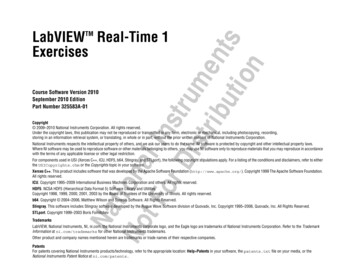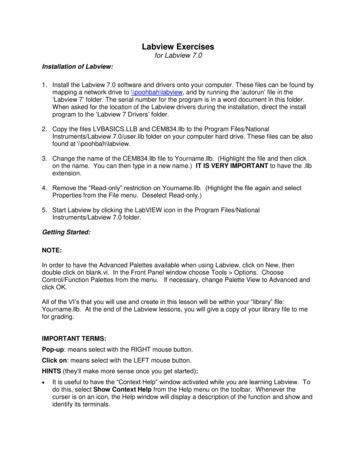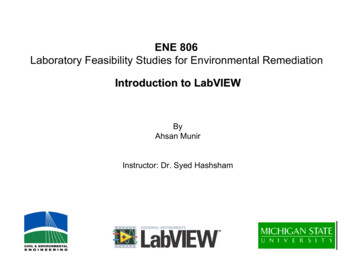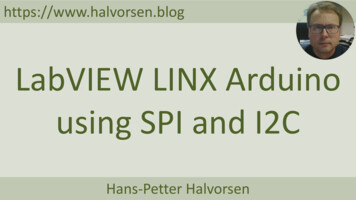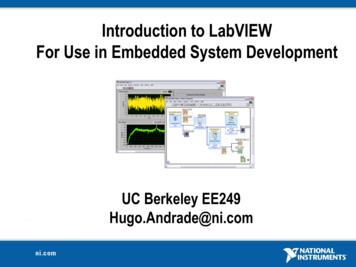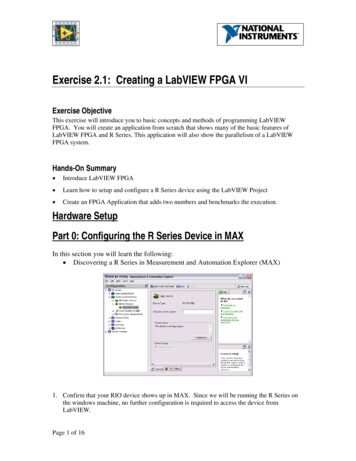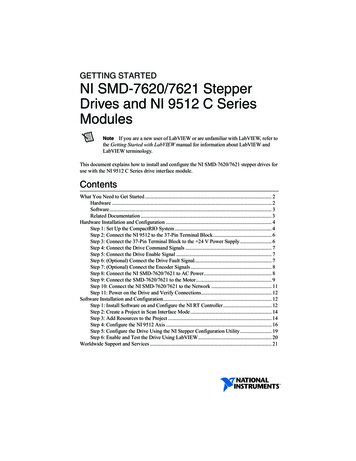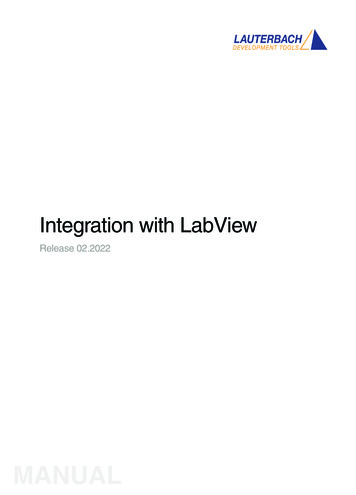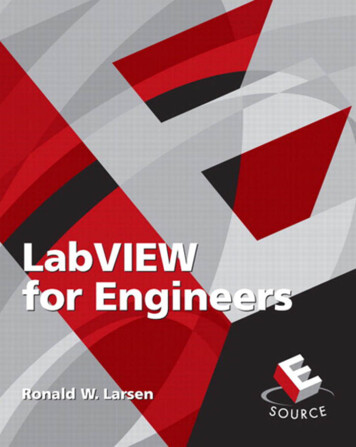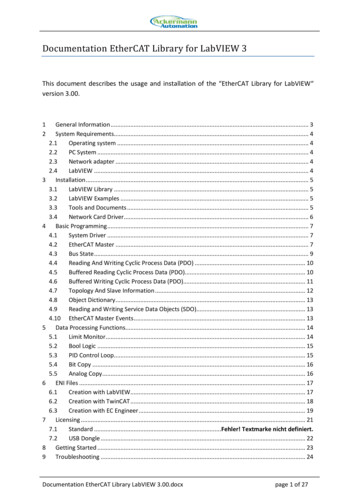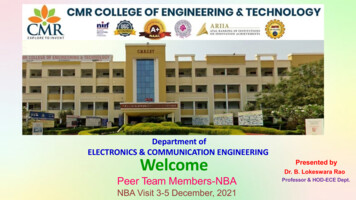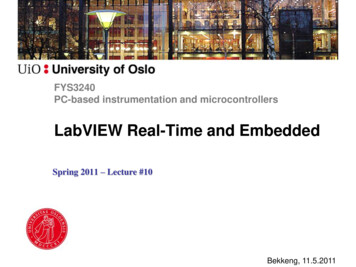
Transcription
FYS3240PC-based instrumentation and microcontrollersLabVIEW Real-Time and EmbeddedSpring 2011 – Lecture #10Bekkeng, 11.5.2011
Embedded Computing An embedded system is a computer system designed toperform one or a few dedicated functions, often with realtime computing constraints. Embedded processors can be microprocessors,microcontrollers or FPGAs. Embedded systems run with limited computer hardwareresources: limited memory, small or non-existent keyboardand/or screen
General Purpose Operating Systems Windows, Linux, MacOS, Unix––––Processor time shared between programsOS can preempt high priority threadsService interrupts –keyboard, mouse, Ethernet Cannot ensure that code finish within specified time limits!
What is a real-time system A real-time system gives you determinism– real-time does not mean “real fast” (it can be slower)!– real-time means that you can determine (predict) accurately whena section of your program will execute Hard real-time– systems where it is absolutely imperative that responses occur within therequired deadline (Example: Flight control systems) Soft real-time– allows for some deadlines to be missed with only a slight degradation inperformance but not a complete failure (example: DAQ-systems) In contrast, on an ordinary desktop PC (with Windows) the OSoperates on a fairness basis– Each application gets time on the CPU regardless of its priority– Even our most time-critical application can be suspended for some routinemaintenance
LabVIEW Real-time (RT) systems The LabVIEW Real-Time Module extends LabVIEW to be able totarget off-the-shelf real-time targets– LabVIEW code can be made to execute with hard real-time performance The application is developed under Windows on a regular PC, andthen downloaded to run on the real-time target
Build vs. Buy for Embedded systems Buy COTS (Commercial-off-the-shelf) hardware when possible Examples of when a custom build in necessary:High volumes (10,000 )An iteration on an existing custom designCustom size or shape requiredVery stringent technical requirements(such as ultralow power consumption)NI paperPCB designers––––
Real-time hardware platforms Desktop PC with real-time OS (RTOS)– as long as the hardware meets certain system requirements PXI with real-time controller– often used for high-performance real-time systems such as hardware-inthe-loop testing NI FPGANI CompactRIONI Single-Board RIONI CompactVisionIndustrial PCs/ControllersNI Compact FieldPoint– a PLC (programmable logic controller)
PXI - NI Real-Time HypervisorCan run real-time OS and Windows on the same controller!
NI CompactRIO platform CompactRIO (cRIO) combines a real-time processor, a FieldProgrammable Gate Array (FPGA), and I/O modules in a small,rugged form factor.Serial, USB, and Ethernet ports are built in to the controller. Whenusing CompactRIO, your I/O modules (e.g. for digital I/O, buscommunication, A/D conversion) are connected to the FPGA for fastprocessing in hardware, and then you exchange data between theFPGA and the real-time processor as desired.4 and 8 slot versions availableProgrammed usingLabVIEW Real-TimeModuleProgrammed usingLabVIEW FPGA Module
NI Single Board RIO NI Single-Board RIO systems are identical in architecture toCompactRIO systems, only in a single circuit board form factorSingle-Board RIO hardware features a real-time processor andprogrammable FPGA just as with CompactRIO, and several I/Omodules are also available in a board-only form factor.Users can easily port applications prototyped on NI CompactRIOhardware to the Single Board RIO (e.g. for high-volume applications)
Input/Output Device comparison
Performance comparison
Ruggedness and portability comparison
LabVIEW – Timed loops Simplifies the way you shedule real-time execution order (bygiving it a priority, a periode/frequency and offset) for parallelloopsdouble-click
Deterministic communication betweenreal-time threads with shared variablesShared variableCan enable use ofRT FIFOShared Variables: Canenable buffering (to avoidlosing data)
Single-Process Shared Variables andLabVIEW Real-Time FIFO In order to maintain determinism, a real-time applicationrequires the use of a nonblocking, deterministic mechanism totransfer data from deterministic sections of the code, such ashigher-priority timed loops and time-critical priority VIs, tonondeterministic sections of the code. When you install theLabVIEW Real-Time Module, you can configure a sharedvariable to use real-time FIFOs by enabling the real-time FIFOfeature from the Shared Variable Properties dialog box.National Instruments recommends using real-time FIFOs totransfer data between a time-critical and a lower-priority loop.You can avoid using the low-level real-time FIFO VIs byenabling the real-time FIFO on a single-process sharedvariable.
NI & LabVIEW Embedded productsWith the NI LabVIEW CCode Generator, you canport your algorithmdesigned using theLabVIEW programmingenvironment to anyprocessor of your choice.
LabVIEW Embedded
LabVIEW Embedded
LabVIEW Embedded systemapplication development Developing the LabVIEW FPGA application for Input/Output(I/O), timing, synchronization, high speed control and signalprocessing. Developing the LabVIEW Real-Time application fordeterministic floating point analysis and control as well ascommunication with a networked host computer. Developing the LabVIEW for Windows application for graphicaluser interfaces, supervisory control and data logging.
NI CompactRIO ReconfigurableEmbedded SystemNote that most communication protocols are non-deterministic, so, in order toensure deterministic performance in your time-critical code, you should notperform communication from within the time-critical VI. Transfer the data to anormal priority VI also running on the RT side to perform your communication.
Architecture for AdvancedCompactRIO ApplicationsUsing Network-PublishedShared variablesData storage is non-deterministic
R-series Intelligent DAQ SystemEmbedded System
Interrupt-Driven Programming In interrupt-driven systems software is designed such that whena registered event, such as a timer, is received, a response isfired to respond to this event. There are two components of any interrupt-driven system: theinterrupt and the interrupt handler. An interrupt is a signal that is generated by hardware, whichindicates an event has occurred that should halt the currentlyexecuting program. Interrupt handlers (also referred to as interrupt service routines- ISRs) are portions of code that are registered with theprocessor to execute once a particular interrupt has occurred.Once the processor is aware of an interrupt, it halts thecurrently executing process, performs a context switch to savethe state of the system, and executes the interrupt handler.Once the interrupt handler code has executed, the processorreturns control to the previously running program.
Interrupt-Driven Programming II For Interrupt-Driven Programming hardware events are detectedand responded to, compared to event driven programming (on aPC) where user interface events trigger some code to be executed
LabVIEW: Interrupts on ARM processors The Interrupt Configuration Wizard makes it easier for you to addhardware interrupt support to hardware targets supported in LabVIEW.Using the project build specifications, select an interrupt and aLabVIEW VI to act as the interrupt handler in your applicationUse the Manage Interrupts page of the ARM Build SpecificationProperties dialog box to enable interrupts and create and configureISR VIs.Using a series of dialogs, you can customize any available hardwareinterrupt in LabVIEW
Interrupts for Data Acquisition In general, there are three approaches to acquiring data froman external device or synchronizing communication betweendevices. These three approaches are described as follows: Polling – This method involves periodically reading the status ofthe device to determine whether the device needs attention. Direct Memory Access (DMA) – A dedicated processor, theDMA controller, transparently transfers data from the device tocomputer memory, or vice versa. Interrupts – the device is configured to interrupt the processorwhenever the device requires attention.
LabVIEW Embedded system application development Developing the LabVIEW FPGA application for Input/Output (I/O), timing, synchronization, high speed control and signal processing. Developing the LabVIEW Real-Time application for deterministic floating point analysis and control as well as communication with a networked host computer.
